It wasn’t until Lamborghini whipped the covers off the stunning Miura in 1966 that the world had really stopped to consider the benefits of a mid-engined layout. Hell, even in the ’50s, Grand Prix cars still had their engines in front of the driver.
This article was first published in the August, 2011 issue of MOTOR
For a performance car, the advantages of mid-mounting the powerplant are pretty obvious. The only problem is that they start and stop – pretty much – with weight distribution.
The mid-engined layout might help handling, but it can also be a bitch to access for servicing, generally rules out a rear seat, restricts luggage space (and shape) and is undoubtedly more expensive to manufacture.
It’s for all those latter reasons that the mid-engined layout has consistently failed to become the default setting for the motor industry. Which is why companies like Ferrari restricts the layout to its sportscars, while its GTs have traditionally been – and remain – front-engined.
But it’s not just Ferrari that makes such a distinction, and the end result is not necessarily a GT, either. Plenty of other manufacturers follow the same set of rules and turn out genuinely good, high-performance cars. And here are three of them right now.
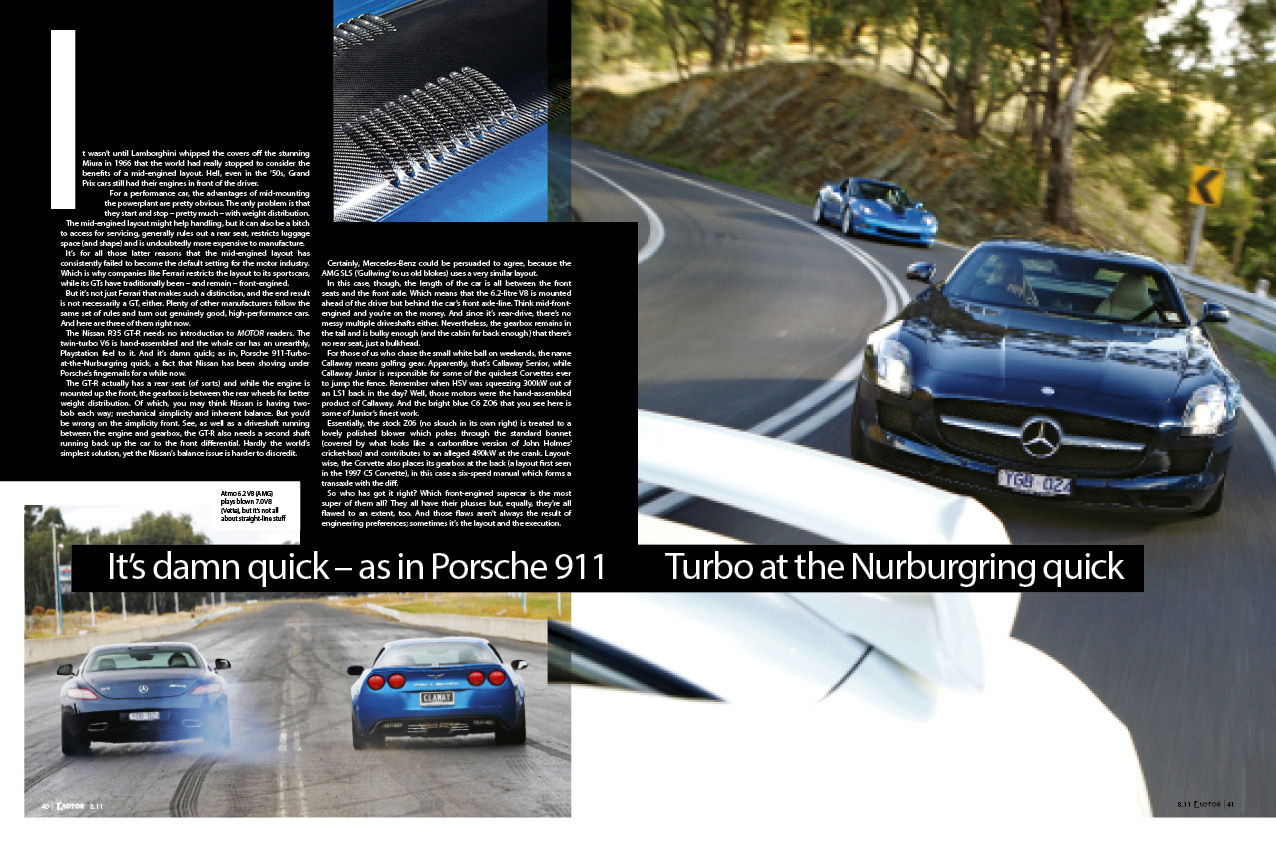
The Nissan R35 GT-R needs no introduction to MOTOR readers. The twin-turbo V6 is hand-assembled and the whole car has an unearthly, Playstation feel to it. And it’s damn quick; as in, Porsche 911-Turbo-at-the-Nurburgring quick, a fact that Nissan has been shoving under Porsche’s fingernails for a while now.
The GT-R actually has a rear seat (of sorts) and while the engine is mounted up the front, the gearbox is between the rear wheels for better weight distribution. Of which, you may think Nissan is having two-bob each way; mechanical simplicity and inherent balance.
But you’d be wrong on the simplicity front. See, as well as a driveshaft running between the engine and gearbox, the GT-R also needs a second shaft running back up the car to the front differential. Hardly the world’s simplest solution, yet the Nissan’s balance issue is harder to discredit.
Certainly, Mercedes-Benz could be persuaded to agree, because the Mercedes-Benz SLS (‘Gullwing’ to us old blokes) uses a very similar layout.
In this case, though, the length of the car is all between the front seats and the front axle. Which means that the 6.2-litre V8 is mounted ahead of the driver but behind the car’s front axle-line. Think mid-front-engined and you’re on the money. And since it’s rear-drive, there’s no messy multiple driveshafts either. Nevertheless, the gearbox remains in the tail and is bulky enough (and the cabin far back enough) that there’s no rear seat, just a bulkhead.
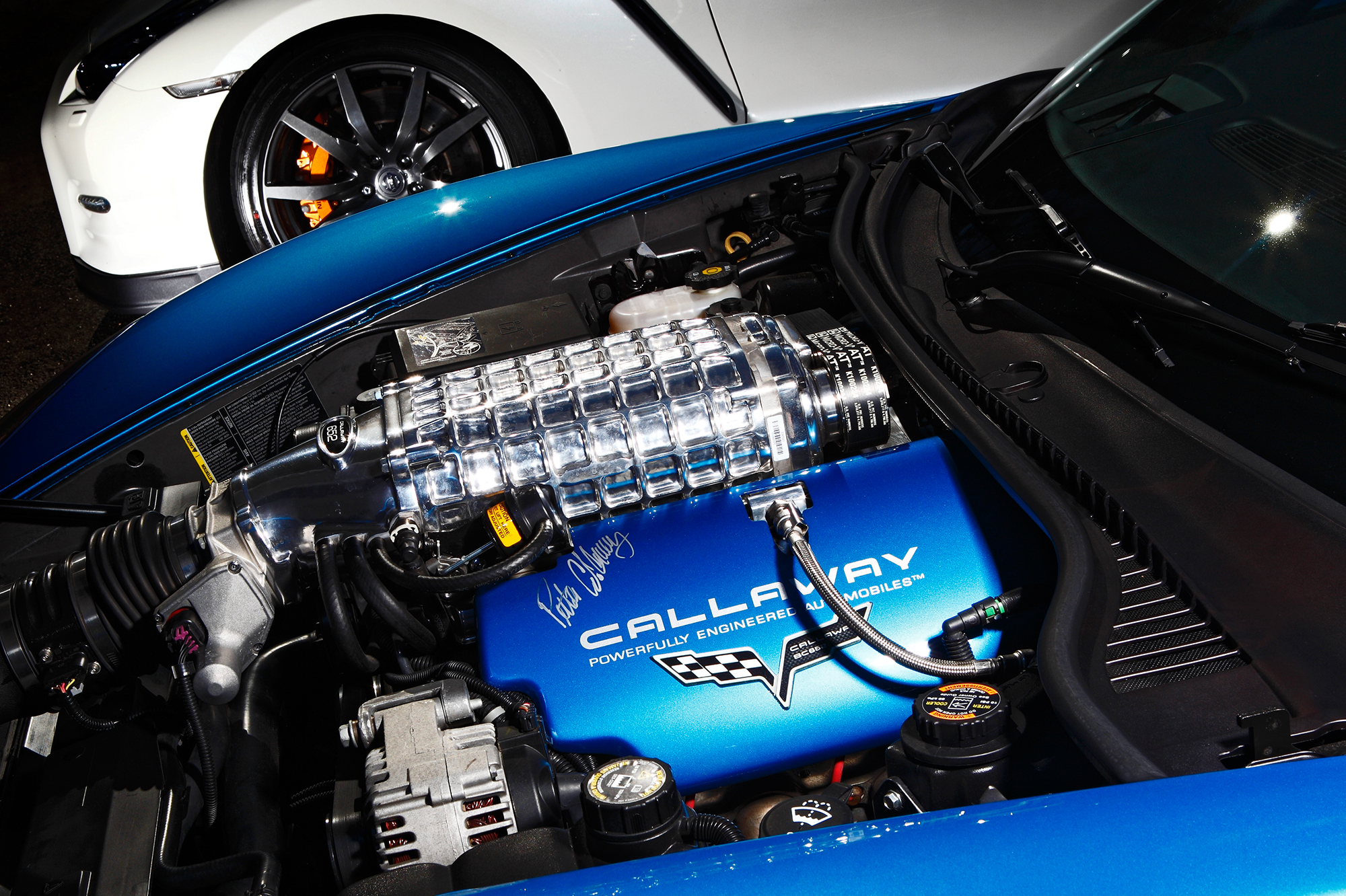
“The GT-R doesn’t have quite the steering feel of the Benz, but it hangs on like very few cars ever made – and pretty much none made at this price”
For those of us who chase the small white ball on weekends, the name Callaway means golfing gear. Apparently, that’s Callaway Senior, while Callaway Junior is responsible for some of the quickest Corvettes ever to jump the fence.
Remember when HSV was squeezing 300kW out of an LS1 back in the day? Well, those motors were the hand-assembled product of Callaway. And the bright blue C6 ZO6 that you see here is some of Junior’s finest work.
Essentially, the stock Z06 (no slouch in its own right) is treated to a lovely polished blower which pokes through the standard bonnet (covered by what looks like a carbonfibre version of John Holmes’ cricket-box) and contributes to an alleged 490kW at the crank. Layout-wise, the Corvette also places its gearbox at the back (a layout first seen in the 1997 C5 Corvette), in this case a six-speed manual which forms a transaxle with the diff.
So who has got it right? Which front-engined supercar is the most super of them all? They all have their plusses but, equally, they’re all flawed to an extent, too. And those flaws aren’t always the result of engineering preferences; sometimes it’s the layout and the execution.
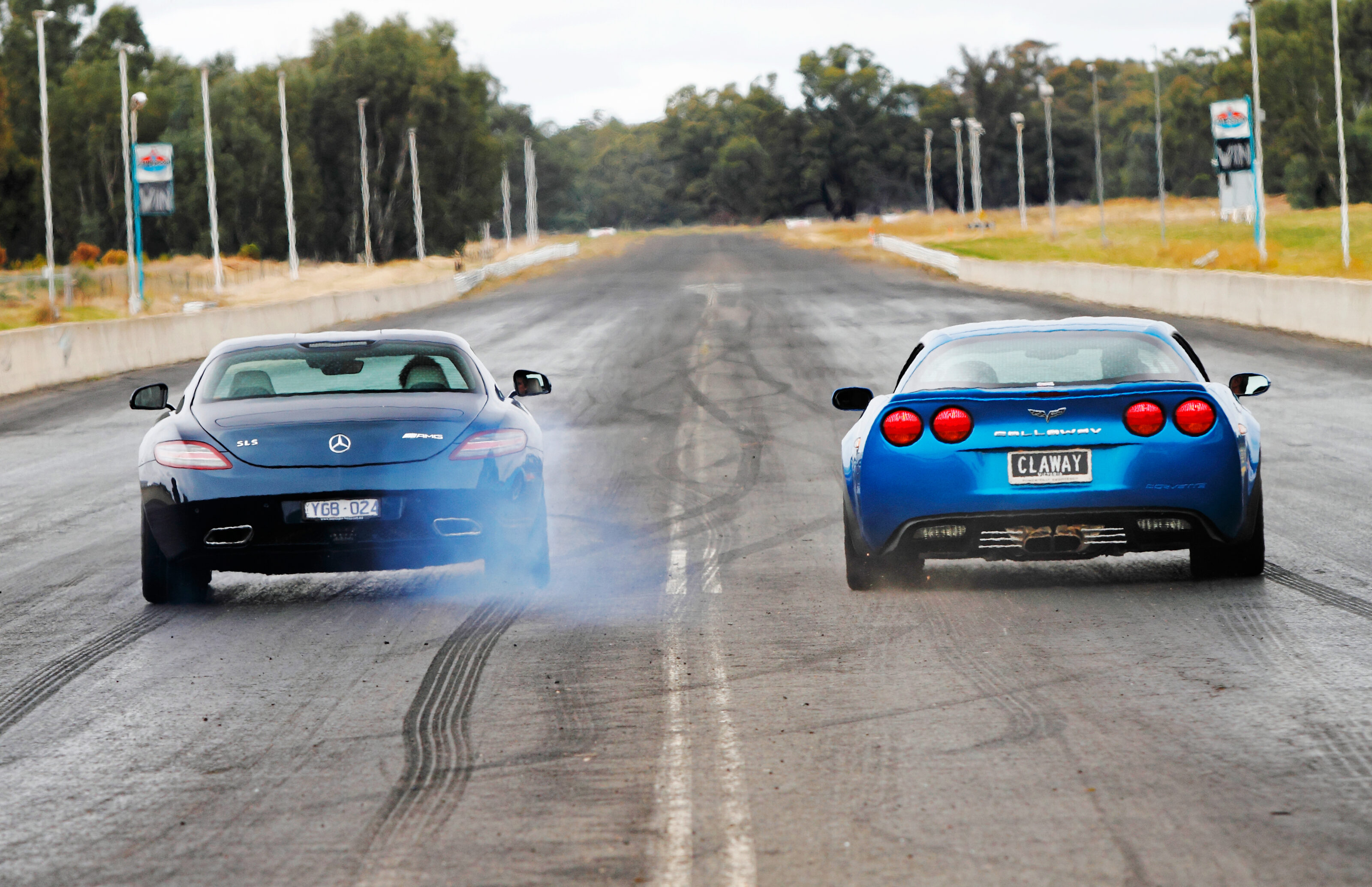
Sometimes it’s as simple as banging your head getting out or having a back seat that isn’t really. Other times – like at ten-tenths – issues like kerb mass or a lack of feedback start to emerge as the glitches. Anyway, here’s our take on it all.
Utter perfection may have eluded them, but the gods of grunt have not deserted the trio. Not a single one of these things is anything other than bugger-me rapid. And that applies even at this, the very pointy end of the performance car spectrum.
The SLS generates enough torque to confuse its own traction control, meaning that a really fast run down the strip requires the human element. We’ve seen this type of thing before in ’roided–up AMGs, but unlike some previous efforts, leaving the traction switched on is not the solution. Nope; you need to shut down the electro-stuff and rely on good old-fashioned seat of the dacks feel and sensitivity.
Get it j-u-s-t right (and it won’t happen every time) and the big AMG will rattle off 0-100km/h in 4.1sec and dash across the first 400m in 11.9 at 202km/h. That terminal velocity also suggests that with more than the rear tyres doing the gripping (or – gasp – bolt slicks to the bugger) it’d hook up and lay down lazy low-11s.
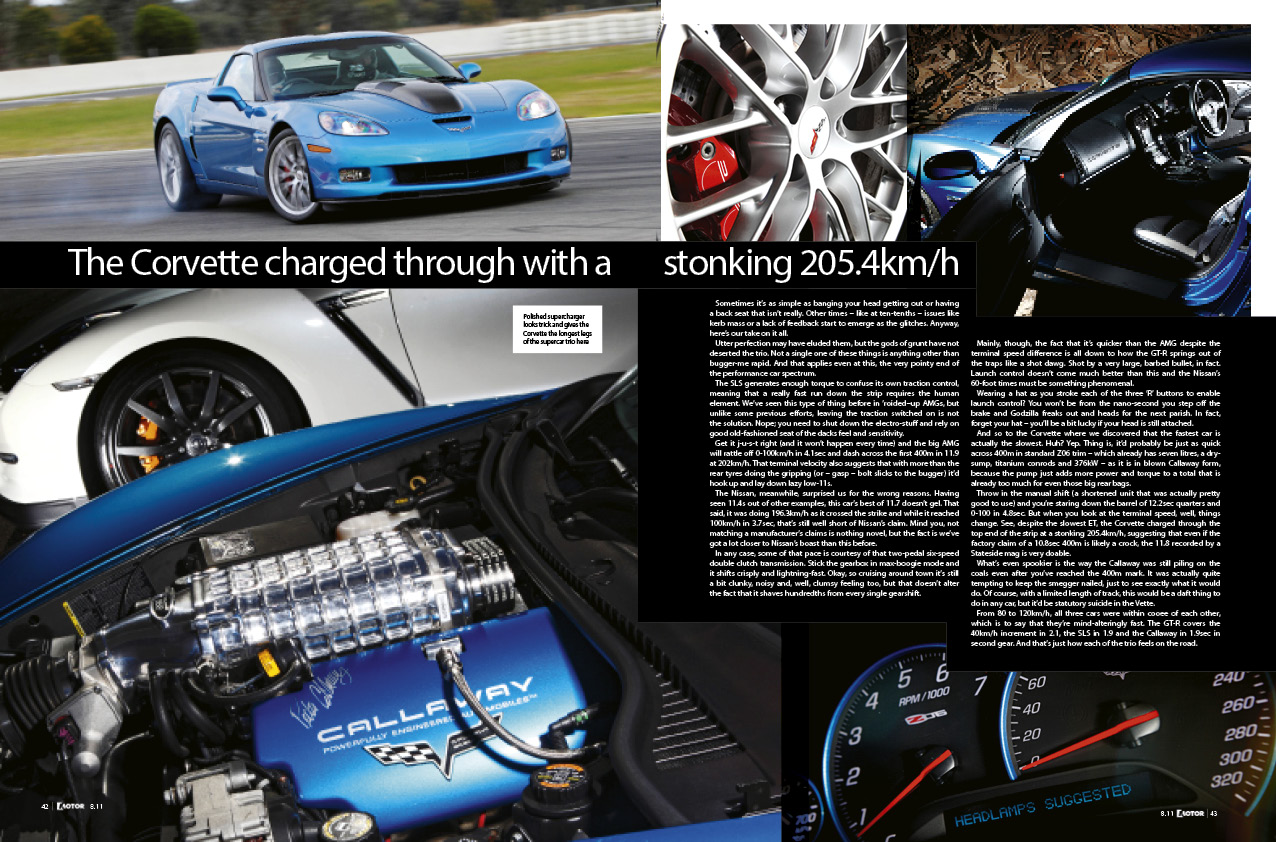
The Nissan, meanwhile, surprised us for the wrong reasons. Having seen 11.4s out of other examples, this car’s best of 11.7 doesn’t gel. That said, it was doing 196.3km/h as it crossed the strike and while it reached 100km/h in 3.7sec, that’s still well short of Nissan’s claim. Mind you, not matching a manufacturer’s claims is nothing novel, but the fact is we’ve got a lot closer to Nissan’s boast than this before.
In any case, some of that pace is courtesy of that two-pedal six-speed double clutch transmission. Stick the gearbox in max-boogie mode and it shifts crisply and lightning-fast. Okay, so cruising around town it’s still a bit clunky, noisy and, well, clumsy feeling too, but that doesn’t alter the fact that it shaves hundredths from every single gearshift.
Mainly, though, the fact that it’s quicker than the AMG despite the terminal speed difference is all down to how the GT-R springs out of the traps like a shot dawg. Shot by a very large, barbed bullet, in fact. Launch control doesn’t come much better than this and the Nissan’s 60-foot times must be something phenomenal.
Wearing a hat as you stroke each of the three ‘R’ buttons to enable launch control? You won’t be from the nano-second you step off the brake and Godzilla freaks out and heads for the next parish. In fact, forget your hat – you’ll be a bit lucky if your head is still attached.
And so, to the Corvette where we discovered that the fastest car is actually the slowest. Huh? Yep. Thing is, it’d probably be just as quick across 400m in standard Z06 trim – which already has seven litres, a dry-sump, titanium conrods and 376kW – as it is in blown Callaway form, because the pump just adds more power and torque to a total that is already too much for even those big rear bags.
Throw in the manual shift (a shortened unit that was actually pretty good to use) and you’re staring down the barrel of 12.2sec quarters and 0-100 in 4.8sec. But when you look at the terminal speed, well, things change. See, despite the slowest ET, the Corvette charged through the top end of the strip at a stonking 205.4km/h, suggesting that even if the factory claim of a 10.8sec 400m is likely a crock, the 11.8 recorded by a Stateside mag is very doable.
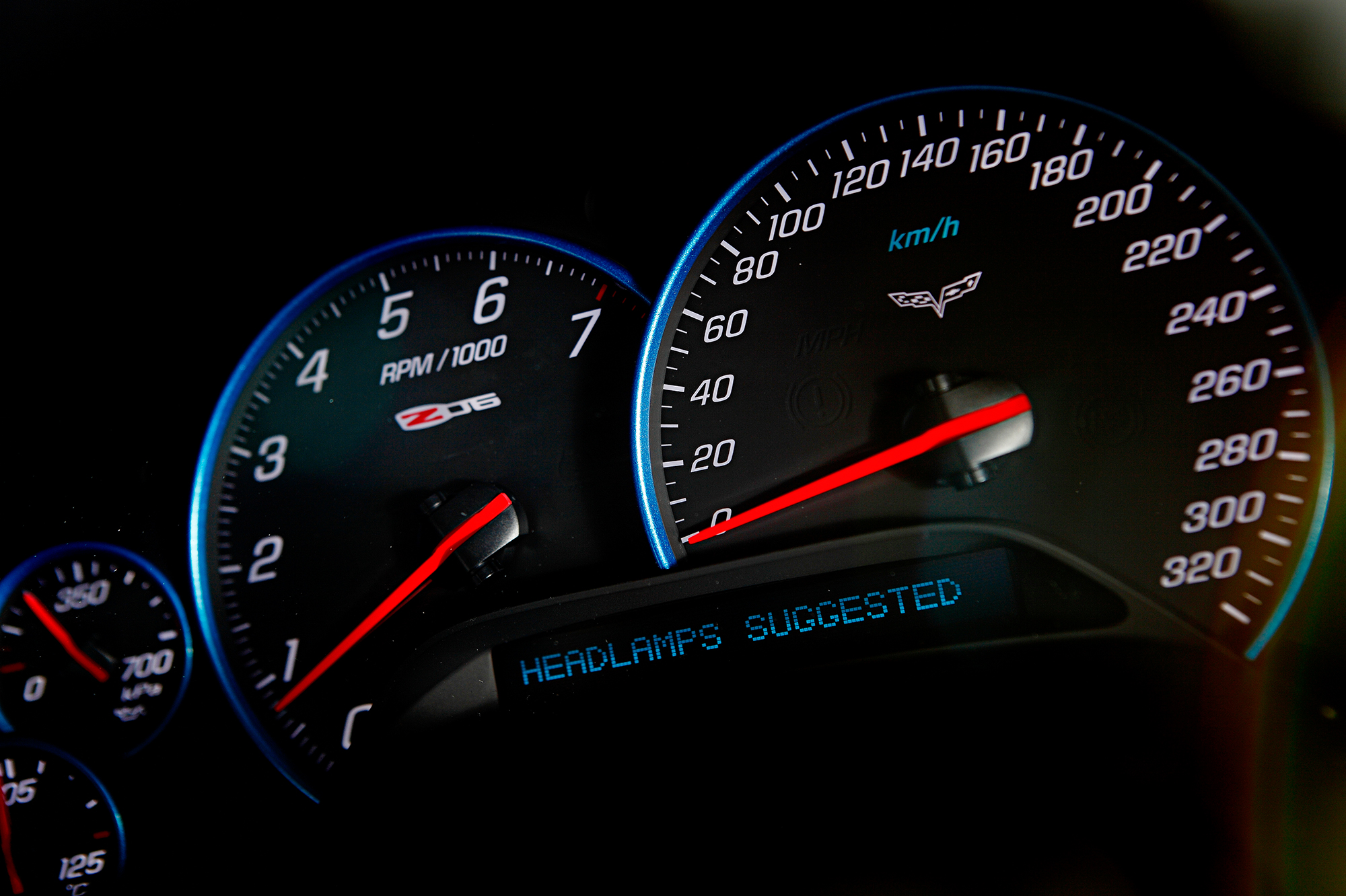
What’s even spookier is the way the Callaway was still piling on the coals even after you’ve reached the 400m mark. It was actually quite tempting to keep the smegger nailed, just to see exactly what it would do. Of course, with a limited length of track, this would be a daft thing to do in any car, but it’d be statutory suicide in the Vette.
From 80 to 120km/h, all three cars were within cooee of each other, which is to say that they’re mind-alteringly fast. The GT-R covers the 40km/h increment in 2.1, the SLS in 1.9 and the Callaway in 1.9sec in second gear. And that’s just how each of the trio feels on the road.
The six-speed DSG in the Nissan can take some waking up (it shifts down each gear one at a time) while the AMG just skips a cog or three and bolts. And the Corvette, pretty much regardless of what gear it’s in, uses that blown torque-wave to simply blast off. Line up an overtake of a B-double in the plastic Yank and you’d be doing serious jail time speeds by the time you were passed and tucked back in.
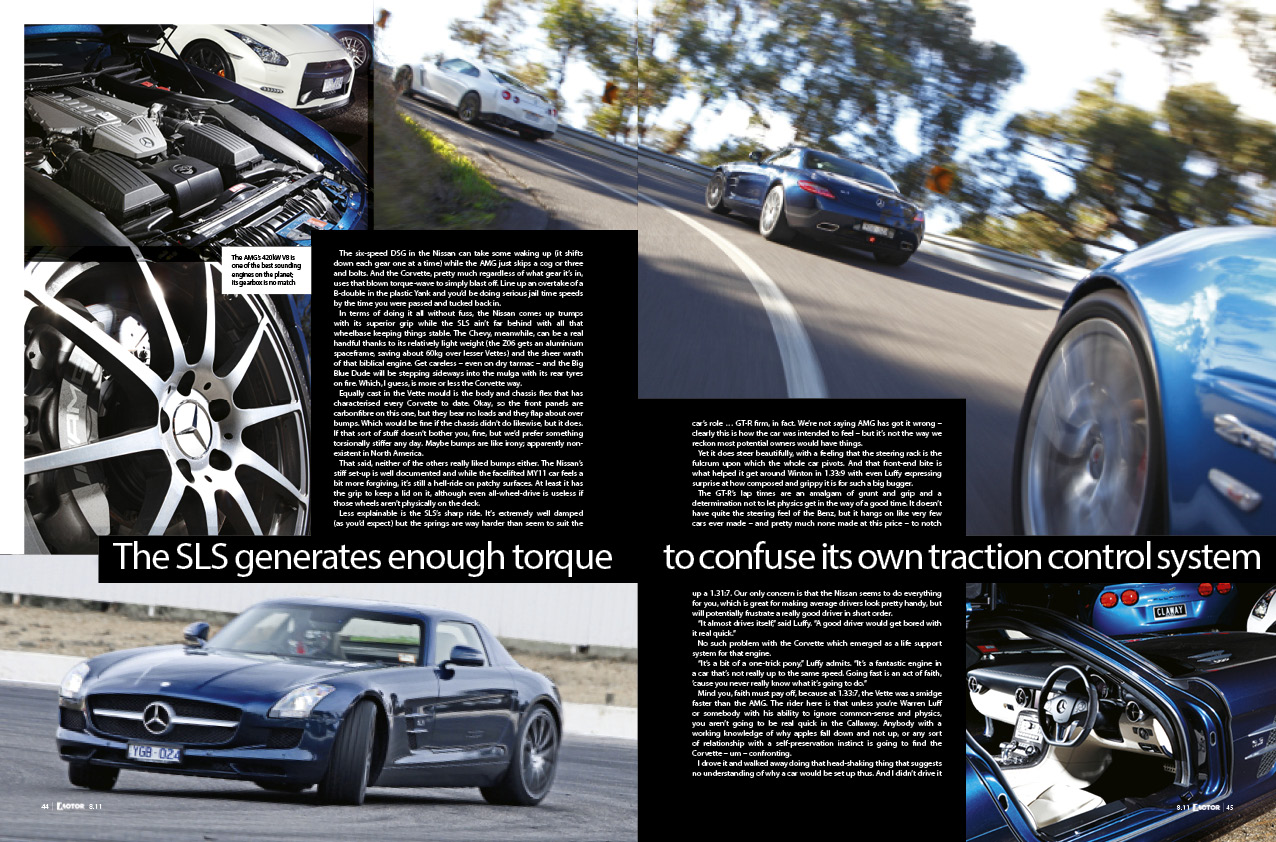
In terms of doing it all without fuss, the Nissan comes up trumps with its superior grip while the SLS ain’t far behind with all that wheelbase keeping things stable. The Chevy, meanwhile, can be a real handful thanks to its relatively light weight (the Z06 gets an aluminium spaceframe, saving about 60kg over lesser Vettes) and the sheer wrath of that biblical engine. Get careless – even on dry tarmac – and the Big Blue Dude will be stepping sideways into the mulga with its rear tyres on fire. Which, I guess, is more or less the Corvette way.
Equally cast in the Vette mould is the body and chassis flex that has characterised every Corvette to date. Okay, so the front panels are carbonfibre on this one, but they bear no loads and they flap about over bumps. Which would be fine if the chassis didn’t do likewise, but it does. If that sort of stuff doesn’t bother you, fine, but we’d prefer something torsionally stiffer any day. Maybe bumps are like irony; apparently non-existent in North America.
That said, neither of the others really liked bumps either. The Nissan’s stiff set-up is well documented and while the facelifted MY11 car feels a bit more forgiving, it’s still a hell-ride on patchy surfaces. At least it has the grip to keep a lid on it, although even all-wheel-drive is useless if those wheels aren’t physically on the deck.
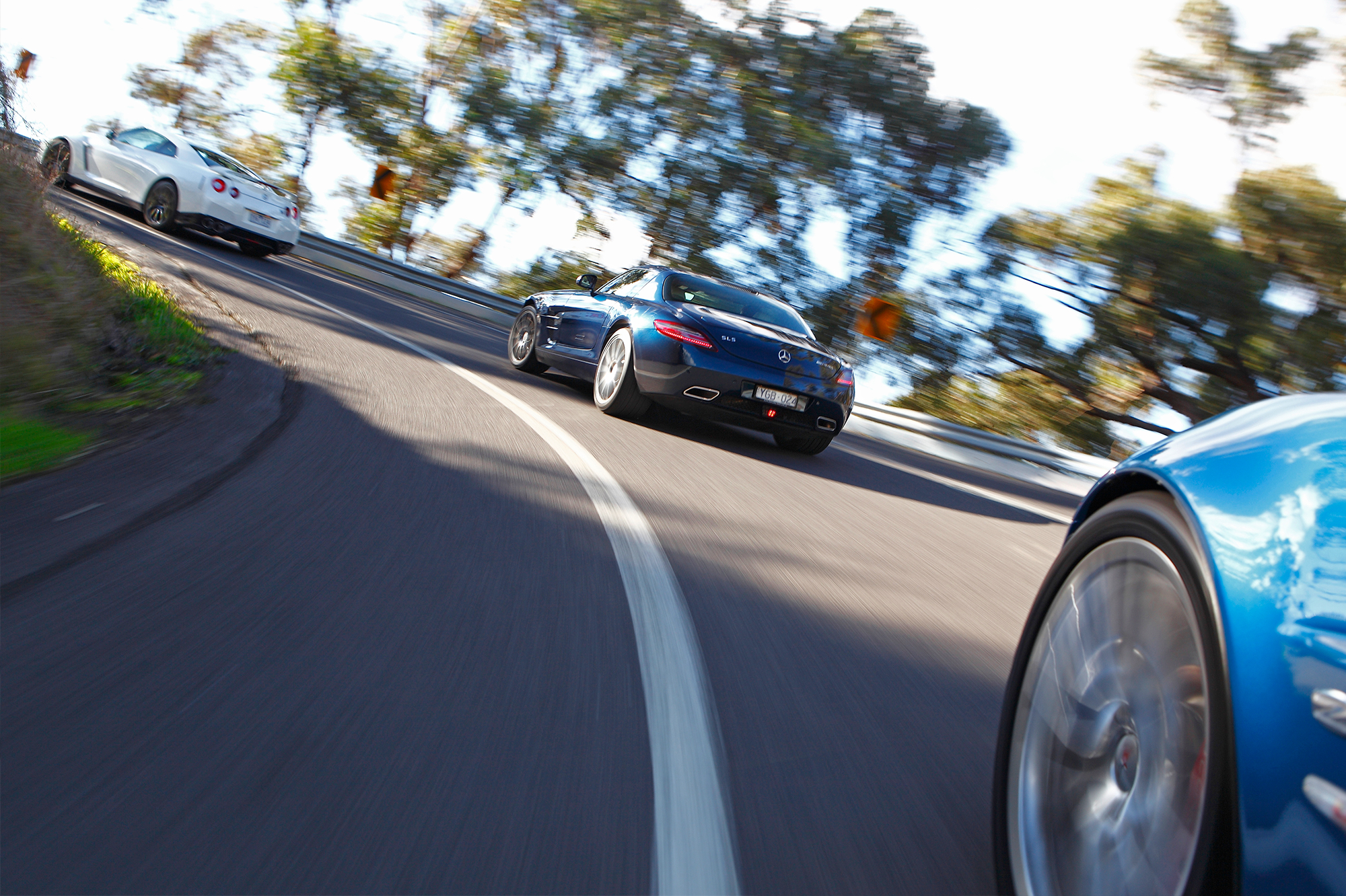
Less explainable is the SLS’s sharp ride. It’s extremely well damped (as you’d expect) but the springs are way harder than seem to suit the car’s role … GT-R firm, in fact. We’re not saying AMG has got it wrong – clearly this is how the car was intended to feel – but it’s not the way we reckon most potential owners would have things.
Yet it does steer beautifully, with a feeling that the steering rack is the fulcrum upon which the whole car pivots. And that front-end bite is what helped it get around Winton in 1.33:9 with even Luffy expressing surprise at how composed and grippy it is for such a big bugger.
The GT-R’s lap times are an amalgam of grunt and grip and a determination not to let physics get in the way of a good time. It doesn’t have quite the steering feel of the Benz, but it hangs on like very few cars ever made – and pretty much none made at this price – to notch up a 1.31:7. Our only concern is that the Nissan seems to do everything for you, which is great for making average drivers look pretty handy, but will potentially frustrate a really good driver in short order.
“It almost drives itself,” said Luffy. “A good driver would get bored with it real quick.”
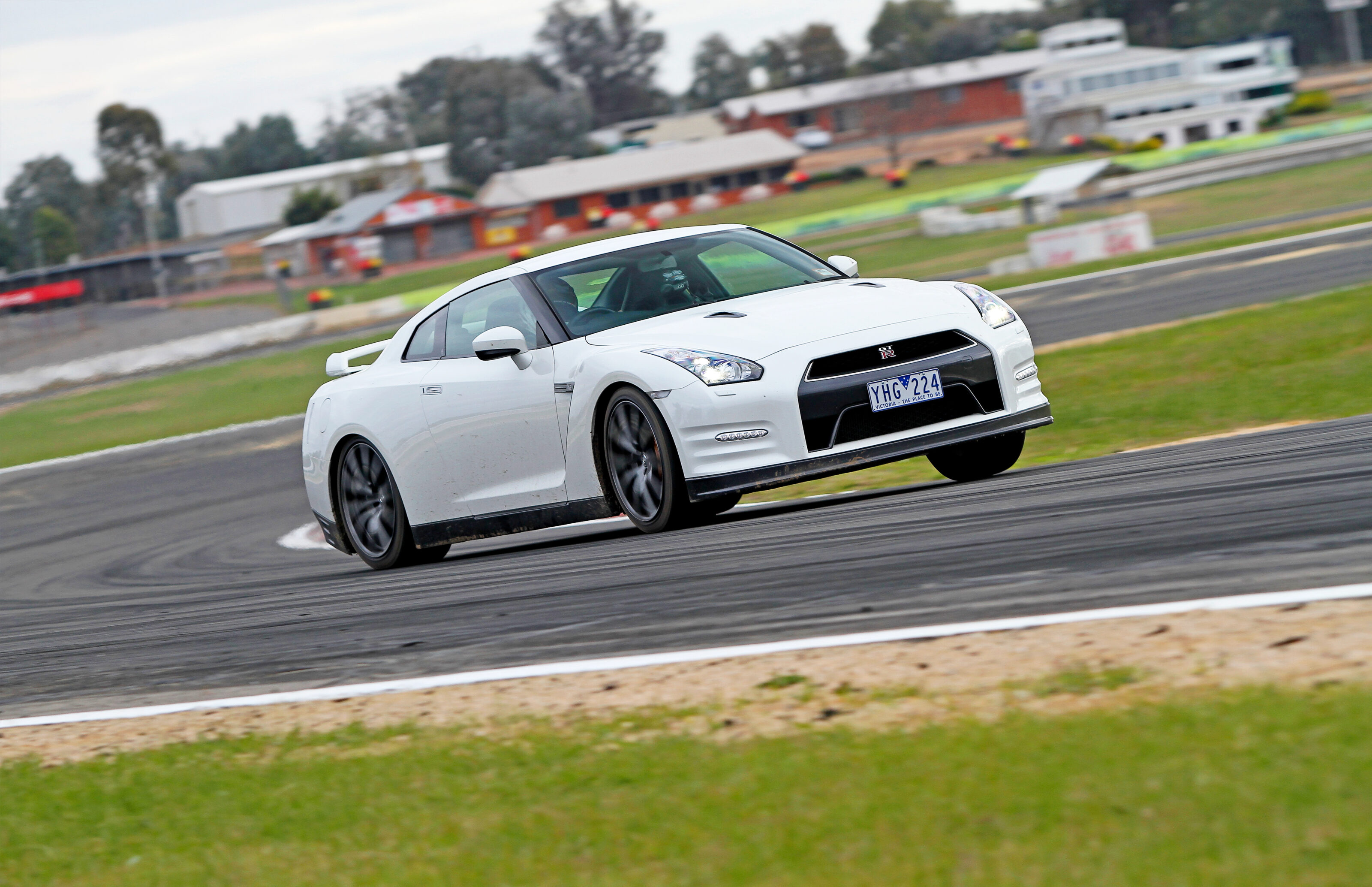
No such problem with the Corvette which emerged as a life support system for that engine.
“It’s a bit of a one-trick pony,” Luffy admits. “It’s a fantastic engine in a car that’s not really up to the same speed. Going fast is an act of faith, ’cause you never really know what it’s going to do.”
Mind you, faith must pay off, because at 1.33:7, the Vette was a smidge faster than the AMG. The rider here is that unless you’re Warren Luff or somebody with his ability to ignore common-sense and physics, you aren’t going to be real quick in the Callaway. Anybody with a working knowledge of why apples fall down and not up, or any sort of relationship with a self-preservation instinct is going to find the Corvette – um – confronting.
I drove it and walked away doing that head-shaking thing that suggests no understanding of why a car would be set up thus. And I didn’t drive it really quick, but getting the loud pedal anywhere near the carpet in the thing requires planning, plenty of clear road ahead and a Medicare card that isn’t yet maxed out.
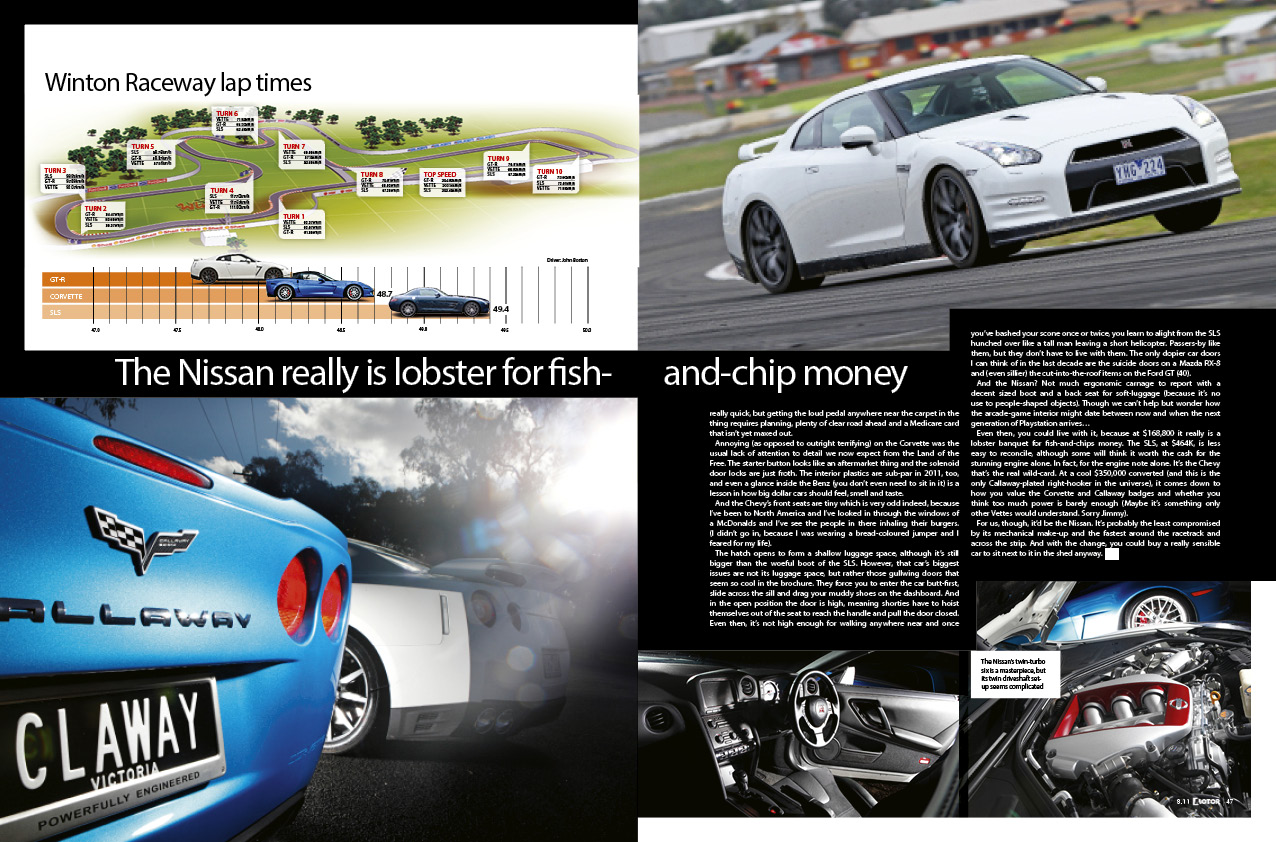
Annoying (as opposed to outright terrifying) on the Corvette was the usual lack of attention to detail we now expect from the Land of the Free. The starter button looks like an aftermarket thing and the solenoid door locks are just froth. The interior plastics are sub-par in 2011, too, and even a glance inside the Benz (you don’t even need to sit in it) is a lesson in how big dollar cars should feel, smell and taste.
And the Chevy’s front seats are tiny which is very odd indeed, because I’ve been to North America and I’ve looked in through the windows of a McDonalds and I’ve see the people in there inhaling their burgers. (I didn’t go in, because I was wearing a bread-coloured jumper and I feared for my life).
The hatch opens to form a shallow luggage space, although it’s still bigger than the woeful boot of the SLS. However, that car’s biggest issues are not its luggage space, but rather those gullwing doors that seem so cool in the brochure. They force you to enter the car butt-first, slide across the sill and drag your muddy shoes on the dashboard. And in the open position the door is high, meaning shorties have to hoist themselves out of the seat to reach the handle and pull the door closed.
Even then, it’s not high enough for walking anywhere near and once you’ve bashed your scone once or twice, you learn to alight from the SLS hunched over like a tall man leaving a short helicopter. Passers-by like them, but they don’t have to live with them. The only dopier car doors I can think of in the last decade are the suicide doors on a Mazda RX-8 and (even sillier) the cut-into-the-roof items on the Ford GT (40).
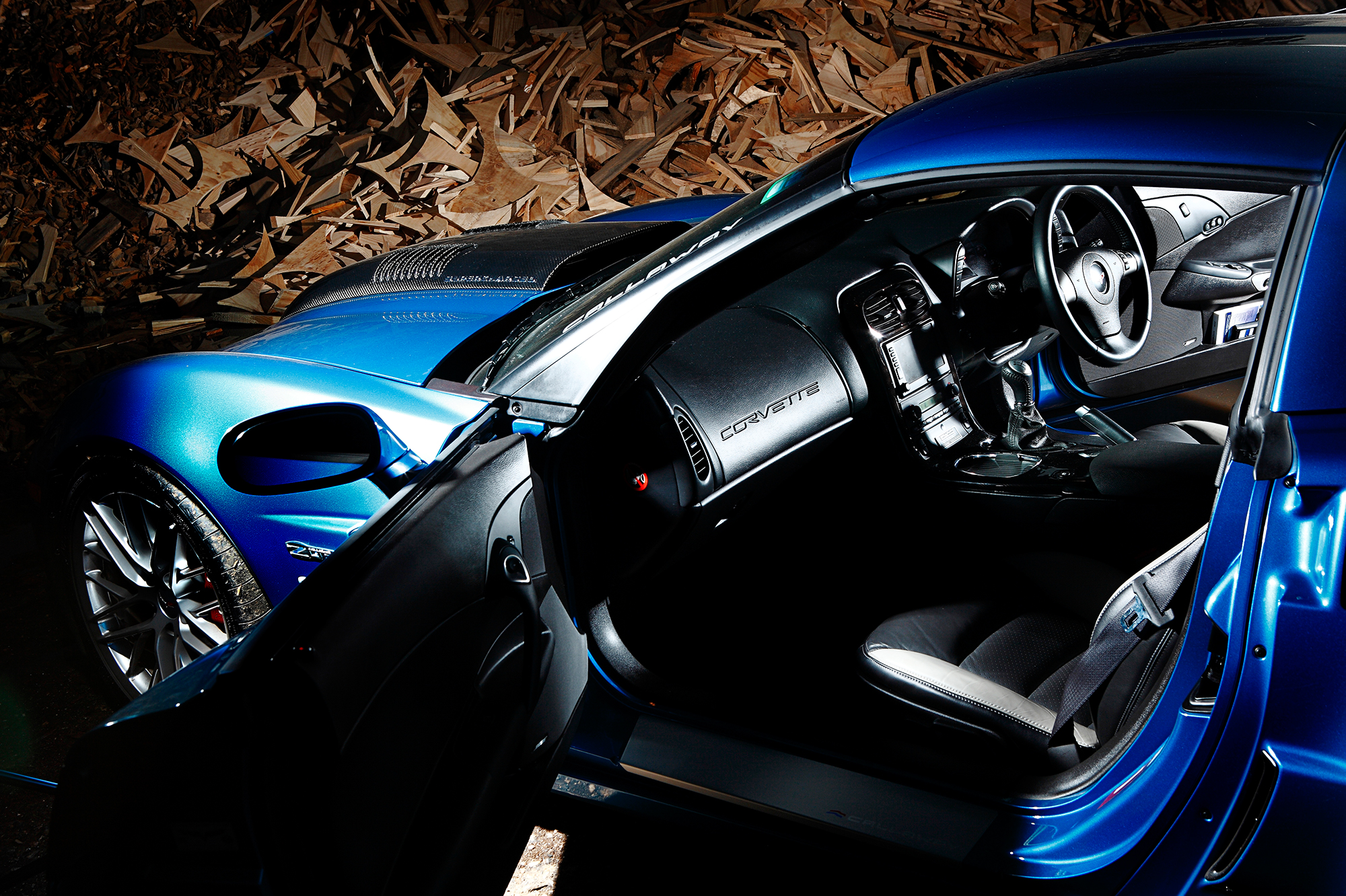
And the Nissan? Not much ergonomic carnage to report with a decent sized boot and a back seat for soft-luggage (because it’s no use to people-shaped objects). Though we can’t help but wonder how the arcade-game interior might date between now and when the next generation of Playstation arrives…
Even then, you could live with it, because at $168,800 it really is a lobster banquet for fish-and-chips money. The SLS, at $464K, is less easy to reconcile, although some will think it worth the cash for the stunning engine alone. In fact, for the engine note alone.
It’s the Chevy that’s the real wild-card. At a cool $350,000 converted (and this is the only Callaway-plated right-hooker in the universe), it comes down to how you value the Corvette and Callaway badges and whether you think too much power is barely enough (Maybe it’s something only other Vettes would understand. Sorry Jimmy).
For us, though, it’d be the Nissan. It’s probably the least compromised by its mechanical make-up and the fastest around the racetrack and across the strip. And with the change, you could buy a really sensible car to sit next to it in the shed anyway.
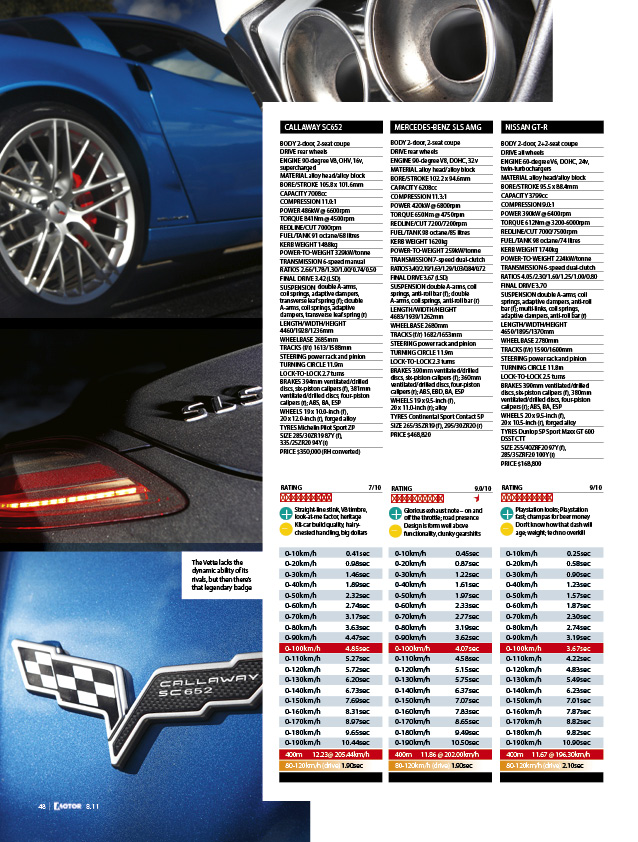
We recommend
-
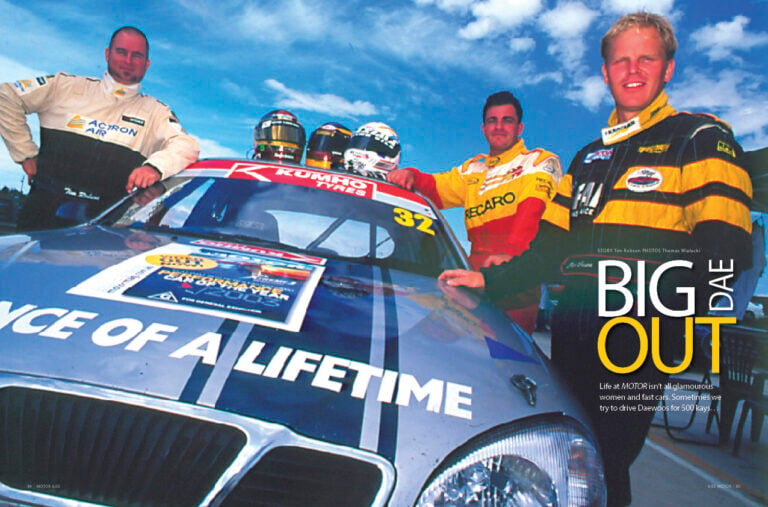 Features
FeaturesWhat happened in MOTOR 18 years ago? We went Daewoo spec-racing on a budget!
MOTOR isn’t all supercars and glamour, we even drove Daewoos once upon a time
-
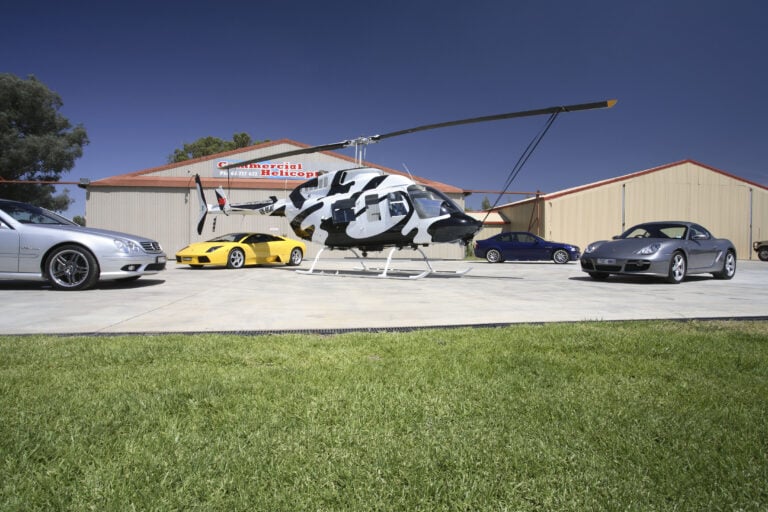 Features
FeaturesWhat happened in MOTOR 15 years ago? We went flat out in 1300kW of fast metal
Throwback to some high-speed hijinks with over $1.4 million of mid-‘00s precious metal
-
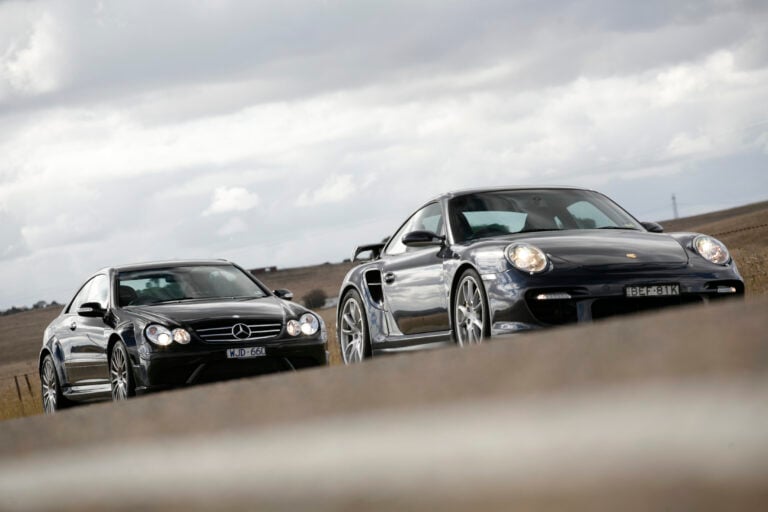 Features
FeaturesWhat happened in MOTOR 13 years ago? We thrashed the 911 GT2 and CLK63 Black on road and track!
Throwback to our day with 763kW and $736,560 worth of dark fast metal





